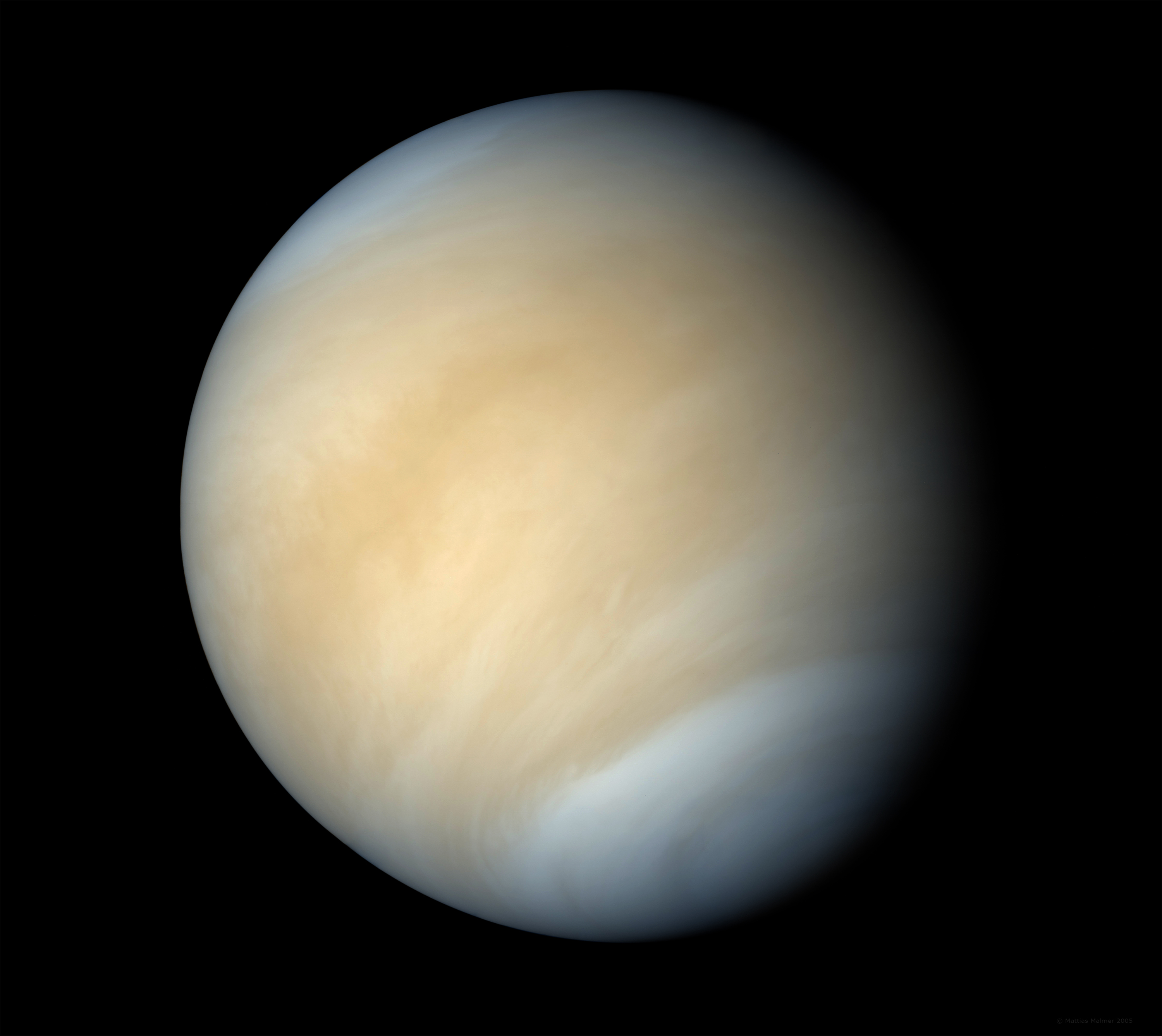Venus is hiding something very, very big.
Every so often, a wave of hot air rises up 40 miles (65 kilometers) from the planet’s Hell-like surface and stretches across its entire diameter. The stationary gravity wave, as its called, hovers above the surface in the shape of a flattened “V”, rippling through the sulfuric acid clouds of Venus that blow by at a chaotic and constant 220 mph.
The anomaly lasts for one or two or maybe three Earth days, then mysteriously vanishes.
It’s invisible to human eyes, but if we had superhuman vision to see it, it might look like a series of ripples in clouds on Earth that stretches all the way from the Arctic to the Antarctic.
Luckily, the instruments of Japan's Venus-orbiting Akatsuki (or Planet-C) spacecraft saw and photographed the anomaly for the first time in infrared light, a form of "heat vision" humans are incapable of:

A group of Japan-based researchers detailed the oddities of Venus' giant, stationary gravity wave in a new study published Monday in the journal Nature Geoscience. Their work implies that it's far bigger than similar waves seen on Earth and Mars, making it "perhaps the greatest ever observed in the solar system."
Yet even after discovering the wave in 2015, scrutinizing photographic evidence of it, and modeling its formation with computer simulations, researchers still don't quite understand what they're looking at.
"It's very bizarre. It has no evident explanations," Thomas Widemann, a planetary scientist at the Paris Observatory who wasn't involved with the new study, told Business Insider. "It's a surprise for all of us."
How gravity waves are born
Gravity waves are well-known to meteorologists and atmospheric scientists, who see them as ripples through clouds of water vapor and ice.
In simplest terms, gravity waves happen as warm, expanding air rises and then suddenly cools, becomes more dense, and falls back down due to gravity.
Such waves look like this on Earth:

As science writer Sarah Kramer once explained in a description of the origin of such waves:
"The layers that make up the atmosphere change temperature and pressure as you rise or fall. When one of the layers hits something (say, a mountain), they push up against it - but gravity pulls them back down. The effect ripples through the other layers, creating waves all the way down.
[...]
"Disturbances in the air, like sudden updrafts or severe thunderstorms, can also make gravity waves. In turn, these can intensify the storms, or even make tornadoes."
On Earth, which has a comfortably dense atmosphere, gravity waves are pretty small. And while Venus is a rocky planet that shares many similarities with our own - it has a persistent atmosphere, clouds, and roughly 82% the mass and 90% the surface gravity of Earth - the two worlds also couldn't be more different.

To put it nicely, Venus today is just about the worst place imaginable to visit in the solar system, and simultaneously an important analog to better understand our own planet, since it's the result of an "extreme" scenario of runaway global warming.
On the surface, the air is nearly 97% carbon dioxide, about 100 times thicker than Earth's atmosphere, and a blistering 864 degrees Fahrenheit (462 degrees Celsius), which is hot enough to melt lead (and why no spacecraft has ever survived more than a few hours there).
"It's a supercritical fluid mixture, not just a gas," Gustavo Costa, a chemist and materials scientist at NASA Glenn Research Center, recently told Business Insider.
Supercritical fluids behave like a gas and a liquid at the same time. If you drink decaffeinated coffee, you benefit from them: supercritical carbon dioxide is typically washed over coffee beans to penetrate deep inside them and dissolve away most of their caffeine.
Which makes the enormous gravity wave on Venus all the more unusual.
One thing scientists are certain of, however, is that it starts above a mountain highland about 2.5 miles (4 kilometers) tall.
A stubby, windy mountain on Venus

Above is an animation of the Venus gravity wave (bow shape, dark and light orange) over a mountainous highland (white contours) located at the planet's equator.
"The fact that it's tied to the surface some 60 kilometers [37 miles] below, that's the shocking part," Sanjay S. Limaye, a planetary scientist at the University of Wisconsin-Madison who wasn't part of the new study, told Business Insider.
Limaye explained that air on Venus is essentially separated into three main layers: its supercritical-fluid surface, a tumultuous yet powerful middle layer, and the high-altitude cloud tops of sulfuric acid that constantly blow westward.
That fast-moving upper layer of clouds, which lap the planet's slow rotation roughly every 4 days - a feature called the "superrotation" of Venus - is where the gravity wave appears, some 65 kilometers (40 miles) high.
"What is amazing about this is, if you look at the atmosphere 50 to 55 kilometers [31 to 34 miles] up, it's pretty chaotic," Limaye said. "How does [a gravity wave] survive that? It should get neutralized there."

Winds may blow over the stubby mountain range at speeds comparable to a gentle breeze, but because the air is a supercritical fluid there, and roughly 100 times denser than the air we breathe, it carries a lot more force - more like a wave in an ocean than a gust of air.
This may help the warm surface air of Venus rise all the way to the cloud tops, and a standalone computer model made by the researchers in Japan could replicate the feature.
William Rossow, an atmospheric scientist at the City College of New York and NASA, told Business Insider in an email that this seems plausible, but wasn't totally convinced the gravity wave goes all the way up to the sulfuric acid cloud tops of Venus.
"[T]he actual disturbance could be much lower in the atmosphere and therefore easier to imagine that topography is causing it," Rossow said.
Still, the Japanese research team spent more than a year analyzing the data, and most scientists Business Insider spoke to say the gravity does appear to reach that high - and that current models of the climate on Venus can't account for the anomaly.
"It's very hard to explain this," Widemann said. "It will probably drive the entire [science] community to revisit our views of the planet's atmosphere."
Unfortunately, Akatsuki is the only spacecraft currently studying Venus, and NASA just funded two missions to asteroids over a new Venus orbiter and lander (plus a telescope to hunt near-Earth asteroids).
"I think this [gravity wave] announcement came maybe 10 days too late," Widemann said. "It's a demonstration that there's something very interesting going on on Venus [...] yet we can't even study our closest neighbor."

